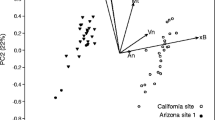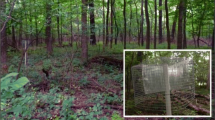Abstract
Three parameters are described for estimating the natural occurrence of chemically defined insect pheromones: (1) the rate and duration of release by the insect, (2) the density of the pheromone-emitting insect population in both time and space, and (3) dispersal and degradation rates of the chemicals. Each of these parameters, except dispersal, was estimated for a population ofDendroctonus brevicomis LeC, and its three component attractive pheromones. A single generation of 610,000 beetles, believed to comprise the entire population in a 65-km2 forest, was estimated to have released 0.78, 3.7, and 370.5 g of frontalin,exo-brevicomin, and myrcene, respectively, within a 30-day period.
Similar content being viewed by others
References
Aylor, D.E. 1976. Estimating peak concentrations of pheromones in the forest, pp. 177–188,in J.F. Anderson and H.K. Kaya (eds.). Perspectives in Forest Entomology. Academic Press, New York.
Barak, A.V., andBurkholder, W.E. 1977. Behavior and pheromone studies withAttagenus elongatulus Casey (Coleoptera; Dermestidae).J. Chem. Ecol. 3:219–237.
Bedard, W.D., andWood, D.L. 1970. Administrative study—field evaluation of synthetic pheromones for suppression and survey of the western pine beetle. Unpublished report on file U.S. Dept. Agric., Forest Service, Pacific S.W. Forest and Range Exp. Sta., P.O. Box 245, Berkeley, California 94701.
Bedard, W.D., andWood, D.L. 1974. Bark beetles—the western pine beetle, pp. 441–449,in M.C. Birch (ed.). Pheromones. North Holland, New York.
Bedard, W.D., Silverstein, R.M., andWood, D.L. 1970. Bark beetle pheromones.Science 167:1638–1639.
Bellas, T.E., Brownlee, R.G., andSilverstein, R.M. 1969. Synthesis of brevicomin, principal sex attractant in the female western pine beetle.Tetrahedron 25:5149–5153.
Borden, J.H. 1977. Behavioral responses of Coleoptera to pheromones, allomones, and kairomones, pp. 169–198,in H.H. Shorey and J.J. McKelvey, Jr. (eds.). Chemical Control of Insect Behavior. John Wiley, New York.
Browne, L.E. 1978. A trapping system for the western pine beetle using attractive pheromones.J. Chem. Ecol. 4:261–275.
Browne, L.E., Birch, M.C., andWood, D.L. 1974. Novel trapping and delivery system for air-borne insect pheromones.J. Insect Physiol. 20:183–193.
Byrne, K.J., Swigar, A.A., Silverstein, R.M., Borden, J.H., andStokkink, E. 1974. Sulcatol: Population aggregation pheromone in the scolytid beetle,Gnathotrichus sulcatus.J. Insect Physiol. 20:1895–1900.
Byrne, K.J., Gore, W.E., Pearce, G.T., andSilverstein, R.M. 1975. Porapak-Q collection of airborne organic compounds serving as models for insect pheromones.J. Chem. Ecol 1:1–7.
Dudley, C.O. 1971. A sample design for the egg and first larval populations of the western pine beetle,Dendroctonus brevicomis (Coleoptera: Scolytidae).Can. Entomol. 103:1291–1313.
Gore, W.E., Pearce, G.T., Lanier, G.N., Simeone, J.B., Silverstein, R.M., Peacock, J.W., andCuthbert, R.A. 1977. Aggregation attraction of the European elm beetle,Scolytus multistriatus: Production of individual components and related aggregation behavior.J. Chem. Ecol. 3:429–446.
Gueldner, R.C., andWiygul, G. 1978. Rhythms in pheromone production of the male boll weevil.Science 199:984–986.
Gustafson, R.W. 1972. Field evaluation of synthetic pheromones for the suppression and survey of western pine beetle, Bass Lake, Sierra National Forest. Unpublished progress report on file U.S. Dept. Agric. Forest Service, Branch of Forest Pest Control, 630 Sansome St., San Francisco, California 94111.
Hammack, L., Ma, M., andBurkholder, W.E. 1976. Sex pheromone-releasing behavior in females of the dermestid beetleTrogoderma glabrum.J. Insect Physiol. 22:555–561.
Kinzer, G.W., Fentiman, A.F., Jr., Page, T.F., Jr., Foltz, R.L., Vité, J.P., andPitman, G.B. 1969. Bark beetle attractants: Identification, synthesis and field bioassay of a new compound isolated fromDendroctonus.Nature 221:447–448.
Ma, M., andBurkholder, W.E. 1978. Sex pheromone releasing behavior ofAnthrenus flavipes (furniture carpet beetles) females (Coleoptera: Dermestidae).Ann. Entomol. Soc. Am. 71:129–133.
Miller, J.M., andKeen, F.P. 1960. Biology and control of the western pine beetle. U.S. Dept. Agric. Misc. Pub. 800. 381 pp.
Mori, K. 1974. Synthesis ofexo-brevicomin, the pheromone of western pine beetle, to obtain optically active forms of known absolute configuration.Tetrahedron 30:4223–4227.
Mori, K. 1975a. Synthesis of optically active forms of frontalin.Tetrahedron 31:1381–1384.
Mori, K. 1975b. Synthesis of optically active forms of sulcatol. The aggregation pheromone in the scolytid beetle,Gnathotrichus sulcatus.Tetrahedron 31:3011–3012.
Payne, T.L. 1974. Pheromone perception, pp. 35–61,in M.C. Birch (ed.). Pheromones. Elsevier, New York.
Roettgering, B. 1973. Field evaluation of synthetic attractants for suppression and survey of the western pine beetle, McCloud Flats, Shasta-Trinity National Forest. Progress Report No. 2. Unpublished report on file U.S. Dept. Agric., Forest Service, Branch of Forest Pest Control, 630 Sansome St., San Francisco, California 94111.
Silverstein, R.M., andYoung, J.C. 1976. Insects generally use multicomponent pheromones, pp. 1–29,in M. Beroza (ed.). Pest Management with Insect Sex Attractants. Am. Chem. Sym. Ser. No. 23. 192 pp.
Stephen, F.M., andDahlsten, D.L. 1976. The temporal and spatial arrival patterns ofDendroctonus brevicomis in ponderosa pine.Can. Entomol. 108:271–282.
Stewart, T.E., Plummer, E.L., McCandless, L.L., West, J.R., andSilverstein, R.M. 1977. Determination of enantiomer composition of several bicyclic ketal insect pheromone components.J. Chem. Ecol. 3:27–43.
Wood, D.L. 1972. Selection and colonization of ponderosa pine by bark beetles, pp. 101–117,in H.F. van Emden (ed.). Insect/Plant Relationships, Symp. Roy. Entomol. Soc. (London) No. 6.
Wood, D.L., andBedard, W.D. 1974. Management of pine bark beetles—a case history—the western pine beetle, pp. 15–20,in T.L. Payne, R.N. Coulson, and R.C. Thatcher (eds.), Southern Pine Beetle, Symp. Texas Agric. Exp. Sta.
Wood, D.L., andBedard, W.D. 1977. The role of pheromones in the population dynamics of the western pine beetle, pp. 643–652,in Natural Factors Affecting Pest Populations. Symp. XV International Congress of Entomology, Washington, D.C., 1976.
Wood, D.L., andBushing, R.W. 1963. The olfactory response ofIps confusus (LeConte) (Coleoptera: Scolytidae) to the secondary attraction in the laboratory.Can. Entomol. 95:1066–1078.
Wood, D.L., Browne, L.E., Ewing, B., Lindhal, K., Bedard, W.D., Tilden, P.E., Mori K., Pitman, G.B., andHughes, P.R. 1976. Western pine beetle: Specificity among enantiomers of male and female components of an attractant pheromone.Science 192:896–898.
Author information
Authors and Affiliations
Additional information
Dendroctonus brevicomis Le Conte (Coleoptera: Scolytidae).
Parts of this report were prepared for the U.S. Forest Service to accompany a future application to the Environmental Protection Agency for registration of these attractants for use in the suppression ofD. brevicomis populations. The research was supported by grants to the University of California (D.L. Wood) from the National Science Foundation/Environmental Protection Agency (NSF-6B-34718/BMS75-04223), Forest Service, U.S. Department of Agriculture and Rockefeller Foundation. The findings, opinions, and recommendations are those of the authors and not necessarily those of these institutions.
Rights and permissions
About this article
Cite this article
Browne, L.E., Wood, D.L., Bedard, W.D. et al. Quantitative estimates of the western pine beetle attractive pheromone components,exo-brevicomin, frontalin, and myrcene in nature. J Chem Ecol 5, 397–414 (1979). https://doi.org/10.1007/BF00987925
Received:
Revised:
Issue Date:
DOI: https://doi.org/10.1007/BF00987925




